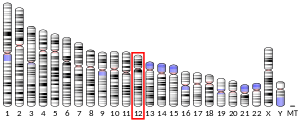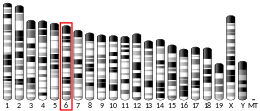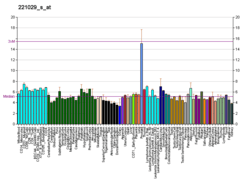WNT5B
Protein Wnt-5b is a protein that in humans is encoded by the WNT5B gene.[5][6]
The WNT gene family consists of structurally-related genes that encode secreted signaling proteins. These proteins have been implicated in oncogenesis and in several developmental processes, including regulation of cell fate and patterning during embryogenesis. This gene is a member of the WNT gene family. It encodes a protein showing 94% and 80% amino acid identity to the mouse Wnt5b protein and the human WNT5A protein, respectively. Alternative splicing of this gene generates two transcript variants.[6]
References
- GRCh38: Ensembl release 89: ENSG00000111186 - Ensembl, May 2017
- GRCm38: Ensembl release 89: ENSMUSG00000030170 - Ensembl, May 2017
- "Human PubMed Reference:". National Center for Biotechnology Information, U.S. National Library of Medicine.
- "Mouse PubMed Reference:". National Center for Biotechnology Information, U.S. National Library of Medicine.
- Saitoh T, Katoh M (Jul 2001). "Molecular cloning and characterization of human WNT5B on chromosome 12p13.3 region". Int J Oncol. 19 (2): 347–51. doi:10.3892/ijo.19.2.347. PMID 11445850.
- "Entrez Gene: WNT5B wingless-type MMTV integration site family, member 5B".
Further reading
- Smolich BD, McMahon JA, McMahon AP, Papkoff J (1994). "Wnt family proteins are secreted and associated with the cell surface". Mol. Biol. Cell. 4 (12): 1267–75. doi:10.1091/mbc.4.12.1267. PMC 275763. PMID 8167409.
- Tanaka K, Okabayashi K, Asashima M, et al. (2000). "The evolutionarily conserved porcupine gene family is involved in the processing of the Wnt family". Eur. J. Biochem. 267 (13): 4300–11. doi:10.1046/j.1432-1033.2000.01478.x. PMID 10866835.
- Saitoh T, Katoh M (2003). "Expression and regulation of WNT5A and WNT5B in human cancer: up-regulation of WNT5A by TNFalpha in MKN45 cells and up-regulation of WNT5B by beta-estradiol in MCF-7 cells". Int. J. Mol. Med. 10 (3): 345–9. doi:10.3892/ijmm.10.3.345. PMID 12165812.
- Strausberg RL, Feingold EA, Grouse LH, et al. (2003). "Generation and initial analysis of more than 15,000 full-length human and mouse cDNA sequences". Proc. Natl. Acad. Sci. U.S.A. 99 (26): 16899–903. doi:10.1073/pnas.242603899. PMC 139241. PMID 12477932.
- Kanazawa A, Tsukada S, Sekine A, et al. (2005). "Association of the Gene Encoding Wingless-Type Mammary Tumor Virus Integration-Site Family Member 5B (WNT5B) with Type 2 Diabetes". Am. J. Hum. Genet. 75 (5): 832–43. doi:10.1086/425340. PMC 1182112. PMID 15386214.
- Gerhard DS, Wagner L, Feingold EA, et al. (2004). "The Status, Quality, and Expansion of the NIH Full-Length cDNA Project: The Mammalian Gene Collection (MGC)". Genome Res. 14 (10B): 2121–7. doi:10.1101/gr.2596504. PMC 528928. PMID 15489334.
- Mangioni S, Viganò P, Lattuada D, et al. (2005). "Overexpression of the Wnt5b gene in leiomyoma cells: implications for a role of the Wnt signaling pathway in the uterine benign tumor". J. Clin. Endocrinol. Metab. 90 (9): 5349–55. doi:10.1210/jc.2005-0272. PMID 15972578.
- Rual JF, Venkatesan K, Hao T, et al. (2005). "Towards a proteome-scale map of the human protein-protein interaction network". Nature. 437 (7062): 1173–8. doi:10.1038/nature04209. PMID 16189514.
This article is issued from Wikipedia. The text is licensed under Creative Commons - Attribution - Sharealike. Additional terms may apply for the media files.




